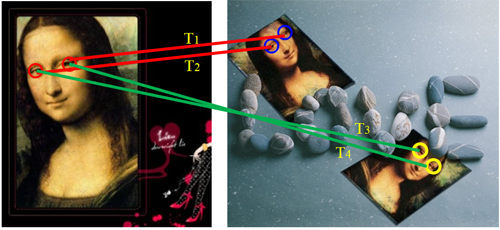Near-duplicate image search technique has great potentials in applications like copyright protection and duplicates filtration in image retrieval. It is a challenging task because the target images are usually modified by a serial of photometric and geometric transformations. Then how to measure the geometric consistency between two images is the key problem for effective near-duplicate image search.

Figure 1. The illustration of local deformation-similarity between correspondences. T1, T2, T3 and T4 represent the deformations of different correspondences. T1 is approximately equal to T2 and T3 is approximately equal to T4.
The recent work of Multimedia Computing Group (MCG) entitled “Efficient Feature Detection and Effective Post-Verification for Large Scale Near-Duplicate Image Search” has achieved great improvement on this point. Considering that the existing measurement mechanisms are either computationally expensive, or have strong assumptions and can only work under particular situation, this work proposed a Pairwise Weak Geometric Consistency (P-WGC) measurement for near-duplicate image search. The key idea is to use geometric consistency between local transformations instead of that between local key-points for measuring geometric consistency. Firstly, as shown in Figure 1, this work unveil that the deformations between different local correspondences display similarity to a certain degree, named local deformation-similarity. Then it is formulized and novelly utilized to quantitatively measure the geometric consistencybetween two local adjacent correspondences. All these consistency scores are represented with a ranked histogram. Based on the significant observation that the histogram of the pair of near-duplicate images has an salient peak, the algorithm extracts the peak score to re-rank the original search results.
P-WGC has several advantages: (1) It can handle not only the uniform transforms (global scale, rotation and translation changes), but also the affine change and nonrigid deformation. (2) It is effective to establish corresponding relationships between multiple visual patterns in two images, even in the case that the transformations of these patterns are different. (3) It has low time-complexity for its simple algorithm and nature of parallelism.
This work will be published by IEEE transaction on Multimedia.
downloadFile